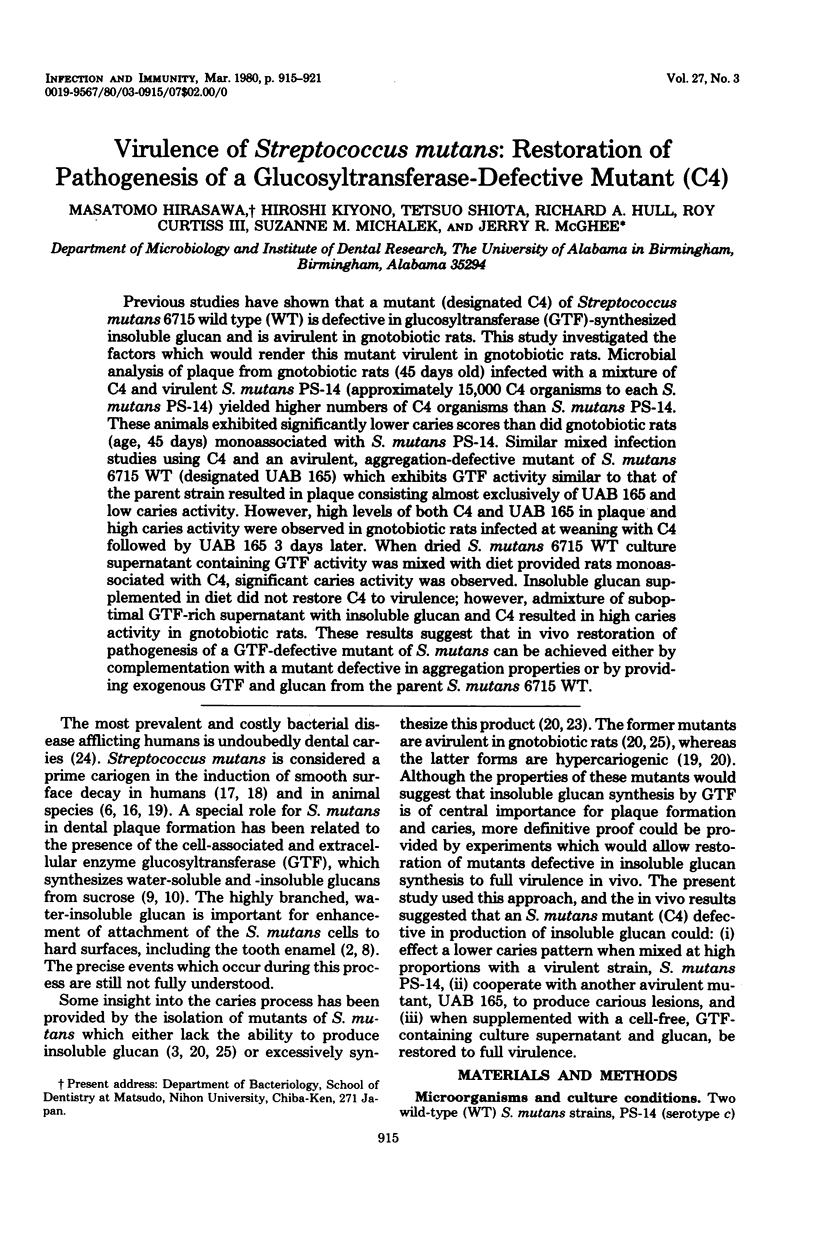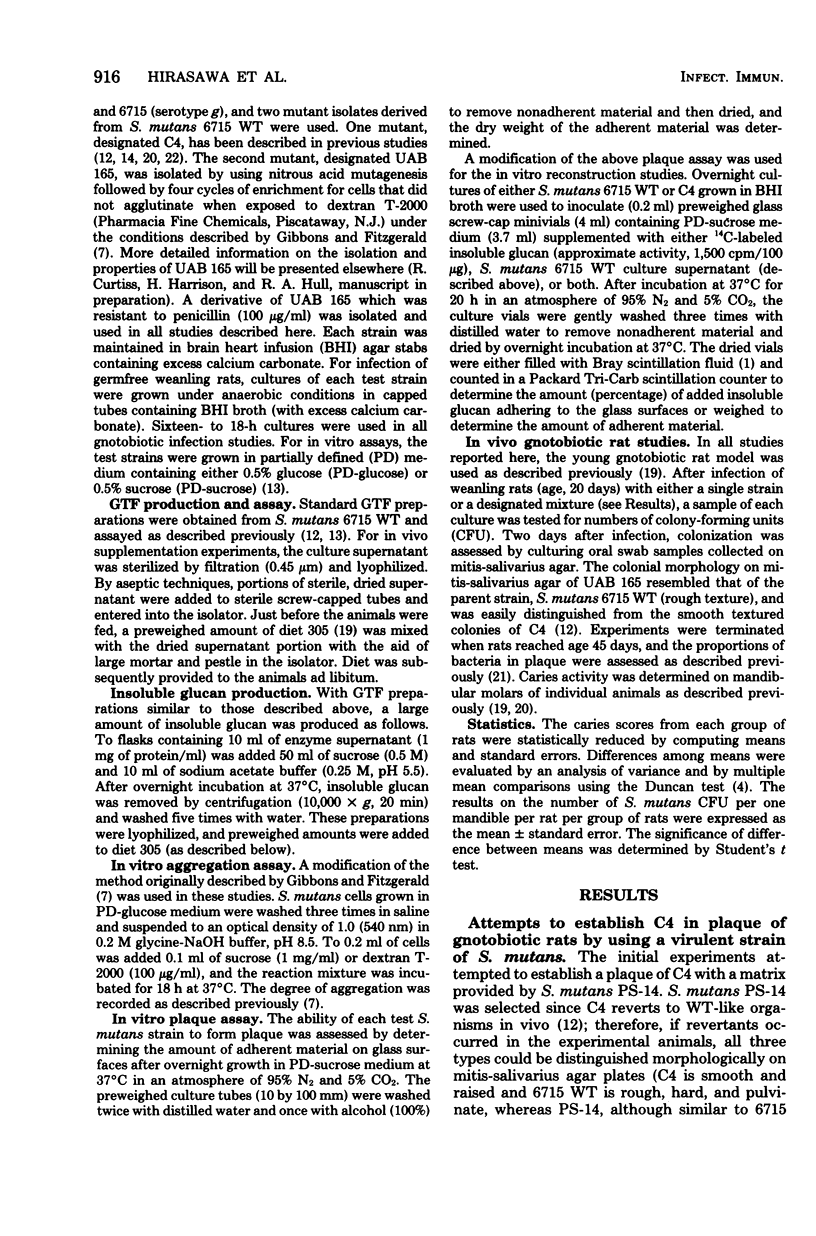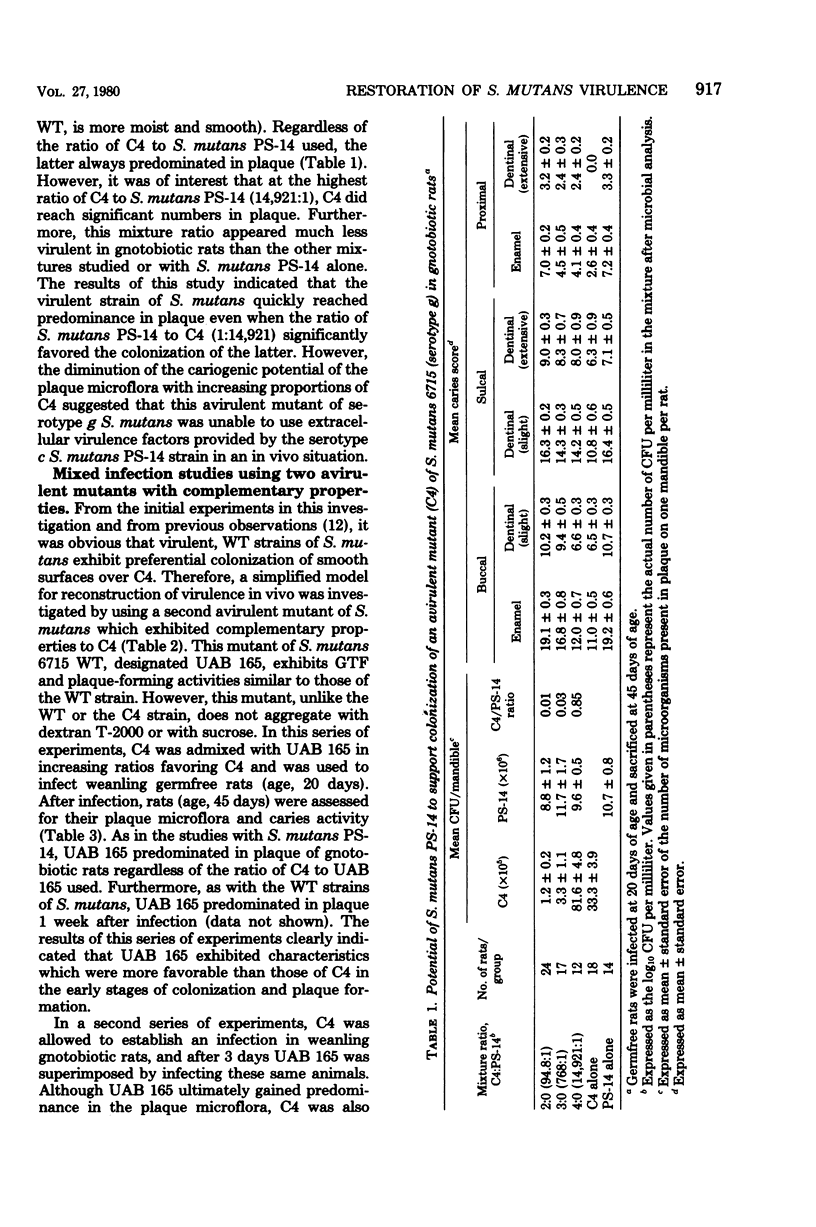Abstract
Previous studies have shown that a mutant (designated C4) of Streptococcus mutans 6715 wild type (WT) is defective in glucosyltransferase (GTF)-synthesized insoluble glucan and is avirulent in gnotobiotic rats. This study investigated the factors which would render this mutant virulent in gnotobiotic rats. Microbial analysis of plaque from gnotobiotic rats (45 days old) infected with a mixture of C4 and virulent S. mutans PS-14 (approximately 15,000 C4 organisms to each S. mutans PS-14) yielded higher numbers of C4 organisms than S. mutans PS-14. These animals exhibited significantly lower caries scores than did gnotobiotic rats (age, 45 days) monoassociated with S. mutans PS-14. Similar mixed infection studies using C4 and an avirulent, aggregation-defective mutant of S. mutans 6715 WT (designated UAB 165) which exhibits GTF activity similar to that of the parent strain resulted in plaque consisting almost exclusively of UAB 165 and low caries activity. However, high levels of both C4 and UAB 165 in plaque and high caries activity were observed in gnotobiotic rats infected at weaning with C4 followed by UAB 165 3 days later. When dried S. mutans 6715 WT culture supernatant containing GTF activity was mixed with diet provided rats monoassociated with C4, significant caries activity was observed. Insoluble glucan supplemented in diet did not restore C4 to virulence; however, admixture of suboptimal GTF-rich supernatant with insoluble glucan and C4 resulted in high caries activity in gnotobiotic rats. These results suggest that in vivo restoration of pathogenesis of a GTF-defective mutant of S. mutans can be achieved either by complementation with a mutant defective in aggregation properties or by providing exogenous GTF and glucan from the parent S. mutans 6715 WT.
Full text
PDF






Selected References
These references are in PubMed. This may not be the complete list of references from this article.
- Ceska M., Granath K., Norrman B., Guggenheim B. Structural and enzymatic studies on glucans synthesized with glucosyltransferases of some strains of oral streptococci. Acta Chem Scand. 1972;26(6):2223–2230. doi: 10.3891/acta.chem.scand.26-2223. [DOI] [PubMed] [Google Scholar]
- Clark W. B., Bammann L. L., Gibbons R. J. Ability of Streptococcus mutans and a glucosyltransferase-defective mutant to colonize rodents and attach to hydroxyapatite surfaces. Infect Immun. 1978 Aug;21(2):681–684. doi: 10.1128/iai.21.2.681-684.1978. [DOI] [PMC free article] [PubMed] [Google Scholar]
- Freedman M. L., Tanzer J. M. Dissociation of plaque formation from glucan-induced agglutination in mutants of Streptococcus mutans. Infect Immun. 1974 Jul;10(1):189–196. doi: 10.1128/iai.10.1.189-196.1974. [DOI] [PMC free article] [PubMed] [Google Scholar]
- Gibbons R. J., Banghart S. Induction of dental caries in gnotobiotic rats with a levan-forming streptococcus and a streptococcus isolated from subacute bacterial endocarditis. Arch Oral Biol. 1968 Mar;13(3):297–308. doi: 10.1016/0003-9969(68)90128-3. [DOI] [PubMed] [Google Scholar]
- Gibbons R. J., Fitzgerald R. J. Dextran-induced agglutination of Streptococcus mutans, and its potential role in the formation of microbial dental plaques. J Bacteriol. 1969 May;98(2):341–346. doi: 10.1128/jb.98.2.341-346.1969. [DOI] [PMC free article] [PubMed] [Google Scholar]
- Gibbons R. J., Houte J. V. Bacterial adherence in oral microbial ecology. Annu Rev Microbiol. 1975;29:19–44. doi: 10.1146/annurev.mi.29.100175.000315. [DOI] [PubMed] [Google Scholar]
- Gibbons R. J., Nygaard M. Synthesis of insoluble dextran and its significance in the formation of gelatinous deposits by plaque-forming streptococci. Arch Oral Biol. 1968 Oct;13(10):1249–1262. doi: 10.1016/0003-9969(68)90081-2. [DOI] [PubMed] [Google Scholar]
- Gibbons R. J., van Houte J. Dental caries. Annu Rev Med. 1975;26:121–136. doi: 10.1146/annurev.me.26.020175.001005. [DOI] [PubMed] [Google Scholar]
- Hillman J. D. Lactate dehydrogenase mutants of Streptococcus mutans: isolation and preliminary characterization. Infect Immun. 1978 Jul;21(1):206–212. doi: 10.1128/iai.21.1.206-212.1978. [DOI] [PMC free article] [PubMed] [Google Scholar]
- Hirasawa M., Kiyono H., Babb J. L., Shiota T., Michalek S. M., McGhee J. R. Virulence of Streptococcus mutans: in vivo reversion of a low-virulence mutant results in partial displacement and pathogenesis. Infect Immun. 1980 Mar;27(3):1003–1011. doi: 10.1128/iai.27.3.1003-1011.1980. [DOI] [PMC free article] [PubMed] [Google Scholar]
- Ikeda T., Otake S., Hirasawa M., Williams K., Kiyoyono H., McGhee J. R., Shiota T. Virulence of Streptococcus mutans: revertants of mutant C4. Infect Immun. 1980 Jan;27(1):25–31. doi: 10.1128/iai.27.1.25-31.1980. [DOI] [PMC free article] [PubMed] [Google Scholar]
- Ikeda T., Shiota T., McGhee J. R., Otake S., Michalek S. M., Ochiai K., Hirasawa M., Sugimoto K. Virulence of Streptococcus mutans: comparison of the effects of a coupling sugar and sucrose on certain metabolic activities and cariogenicity. Infect Immun. 1978 Feb;19(2):477–480. doi: 10.1128/iai.19.2.477-480.1978. [DOI] [PMC free article] [PubMed] [Google Scholar]
- Koga T., Inoue M. Cellular adherence, glucosyltransferase adsorption, and glucan synthesis of Streptococcus mutans AHT mutants. Infect Immun. 1978 Feb;19(2):402–410. doi: 10.1128/iai.19.2.402-410.1978. [DOI] [PMC free article] [PubMed] [Google Scholar]
- Krasse B., Carlsson J. Various types of streptococci and experimental caries in hamsters. Arch Oral Biol. 1970 Jan;15(1):25–32. doi: 10.1016/0003-9969(70)90142-1. [DOI] [PubMed] [Google Scholar]
- Krasse B., Edwardsson S., Svensson I., Trell L. Implantation of caries-inducing streptococci in the human oral cavity. Arch Oral Biol. 1967 Feb;12(2):231–236. doi: 10.1016/0003-9969(67)90042-8. [DOI] [PubMed] [Google Scholar]
- Loesche W. J., Rowan J., Straffon L. H., Loos P. J. Association of Streptococcus mutants with human dental decay. Infect Immun. 1975 Jun;11(6):1252–1260. doi: 10.1128/iai.11.6.1252-1260.1975. [DOI] [PMC free article] [PubMed] [Google Scholar]
- Michalek S. M., McGhee J. R., Navia J. M. Virulence of Streptococcus mutans: a sensitive method for evaluating cariogenicity in young gnotobiotic rats. Infect Immun. 1975 Jul;12(1):69–75. doi: 10.1128/iai.12.1.69-75.1975. [DOI] [PMC free article] [PubMed] [Google Scholar]
- Michalek S. M., McGhee J. R., Shiota T., Devenyns D. Low sucrose levels promote extensive Streptococcus mutans-induced dental caries. Infect Immun. 1977 May;16(2):712–714. doi: 10.1128/iai.16.2.712-714.1977. [DOI] [PMC free article] [PubMed] [Google Scholar]
- Michalek S. M., Shiota T., Ikeda T., Navia J. M., McGhee J. R. Virulence of Streptococcus mutans: biochemical and pathogenic characteristics of mutant isolates. Proc Soc Exp Biol Med. 1975 Nov;150(2):498–502. doi: 10.3181/00379727-150-39064. [DOI] [PubMed] [Google Scholar]
- Otake S., McGhee J. R., Hirasawa M., Williams K., Arnold R. R., Babb J. L., Kiyono H., Cox C., Michalek S. M., Shiota T. Use of mutants in the elucidation of virulence of Streptococcus mutans. Adv Exp Med Biol. 1978;107:673–683. doi: 10.1007/978-1-4684-3369-2_76. [DOI] [PubMed] [Google Scholar]
- Schachtele C. F., Germaine G. R., Harlander S. K. Production of elevated levels of dextransucrase by a mutant of Streptococcus mutans. Infect Immun. 1975 Oct;12(4):934–937. doi: 10.1128/iai.12.4.934-937.1975. [DOI] [PMC free article] [PubMed] [Google Scholar]
- Scherp H. W. Dental caries: prospects for prevention. Science. 1971 Sep 24;173(4003):1199–1205. doi: 10.1126/science.173.4003.1199. [DOI] [PubMed] [Google Scholar]
- Tanzer J. M., Freedman M. L., Fitzgerald R. J., Larson R. H. Diminished virulence of glucan synthesis-defective mutants of Streptococcus mutans. Infect Immun. 1974 Jul;10(1):197–203. doi: 10.1128/iai.10.1.197-203.1974. [DOI] [PMC free article] [PubMed] [Google Scholar]
- Van Houte J., Upeslacis V. N., Jordan H. V., Skobe Z., Green D. B. Role of sucrose in colonization of Streptococcus mutans in conventional Sprague-Dawley rats. J Dent Res. 1976 Mar-Apr;55(2):202–215. doi: 10.1177/00220345760550020801. [DOI] [PubMed] [Google Scholar]
- Van Houte J., Upeslacis V. N. Studies of the mechanism of sucrose-associated colonization of Streptococcus mutans on teeth of conventional rats. J Dent Res. 1976 Mar-Apr;55(2):216–222. doi: 10.1177/00220345760550020901. [DOI] [PubMed] [Google Scholar]
- van Houte J., Burgess R. C., Onose H. Oral implantation of human strains of Streptococcus mutans in rats fed sucrose or glucose diets. Arch Oral Biol. 1976;21(9):561–564. doi: 10.1016/0003-9969(76)90023-6. [DOI] [PubMed] [Google Scholar]


